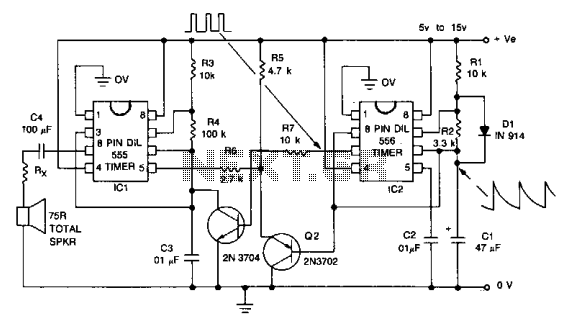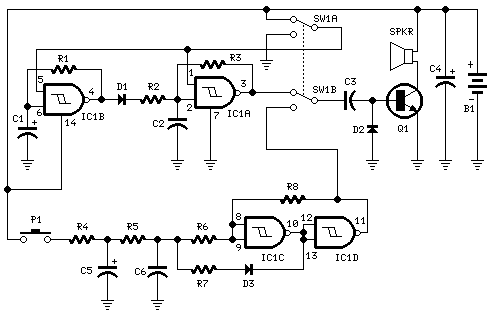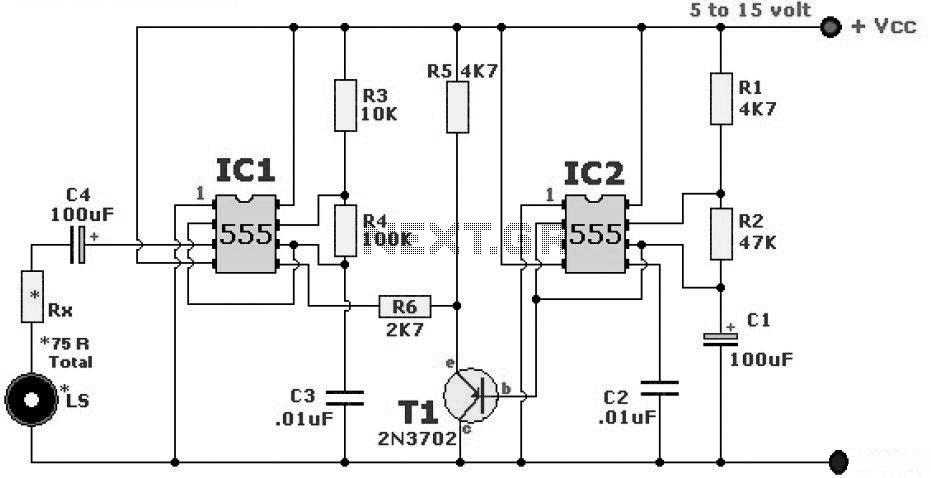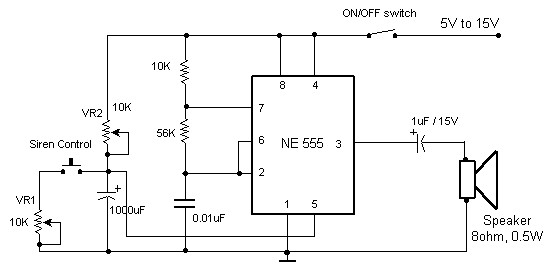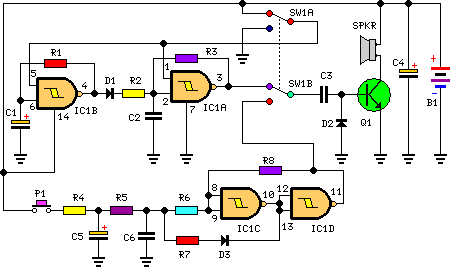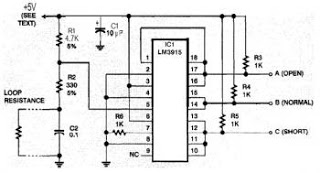
powerful security siren
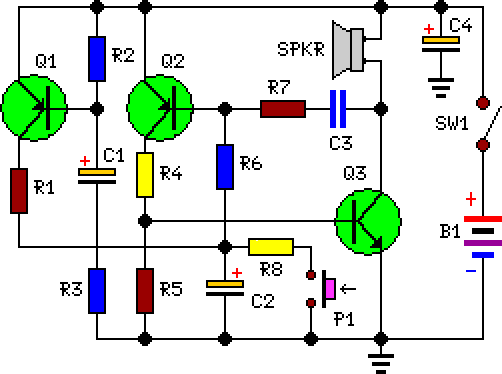
A complementary transistor pair (Q2 and Q3) is configured as a high-efficiency oscillator that directly drives the loudspeaker. Q1 is responsible for fully charging capacitor C2 when power is applied to the circuit. When switch P1 is pressed, C2 discharges gradually through resistor R8, causing the circuit to oscillate at a low frequency that slowly increases until it stabilizes at a high tone, which continues indefinitely. Upon releasing P1, the output tone frequency gradually decreases as C2 recharges to the battery's positive voltage through resistor R6 and the base-emitter junction of Q2. Once C2 is fully charged, the circuit ceases oscillation and enters a standby state.
The circuit utilizes a complementary push-pull configuration with transistors Q2 and Q3, which work together to enhance efficiency and output power. This arrangement allows for effective driving of the loudspeaker while minimizing power loss. Transistor Q1 acts as a charge pump, ensuring that capacitor C2 is adequately charged when the circuit is powered on. The gradual discharge of C2 through resistor R8 is crucial for achieving the desired low-frequency oscillation that ramps up to a higher frequency.
The behavior of the circuit is influenced by the values of the components involved. Resistor R8 controls the discharge rate of C2, thereby determining how quickly the oscillation frequency increases. The design choice of using a complementary pair of transistors ensures that both halves of the waveform are amplified, leading to a more robust output signal to the loudspeaker.
When P1 is released, the recharging of C2 through R6 and the base-emitter junction of Q2 provides a feedback mechanism that allows for a smooth transition back to a lower frequency tone. The circuit's ability to halt oscillation once C2 reaches full charge is an essential feature, preventing unnecessary power consumption and allowing the system to enter a low-power standby mode. This functionality is significant in applications where energy efficiency is paramount.
Overall, this oscillator circuit design exemplifies a practical application of transistor technology in audio systems, demonstrating how component selection and configuration can yield efficient performance in sound generation.A complementary transistor pair (Q2 & Q3) is wired as a high efficiency oscillator, directly driving the loudspeaker. Q1 ensures a full charge of C2 when power is applied to the circuit. Pressing on P1, C2 gradually discharges through R8: the circuit starts oscillating at a low frequency that increases slowly until a high steady tone is reached and kept indefinitely.
When P1 is released, the output tone frequency decreases slowly as C2 is charged to the battery positive voltage through R6 and the Base-Emitter junction of Q2. When C2 is fully charged the circuit stops oscillating, reaching a stand-by status.. 🔗 External reference
The circuit utilizes a complementary push-pull configuration with transistors Q2 and Q3, which work together to enhance efficiency and output power. This arrangement allows for effective driving of the loudspeaker while minimizing power loss. Transistor Q1 acts as a charge pump, ensuring that capacitor C2 is adequately charged when the circuit is powered on. The gradual discharge of C2 through resistor R8 is crucial for achieving the desired low-frequency oscillation that ramps up to a higher frequency.
The behavior of the circuit is influenced by the values of the components involved. Resistor R8 controls the discharge rate of C2, thereby determining how quickly the oscillation frequency increases. The design choice of using a complementary pair of transistors ensures that both halves of the waveform are amplified, leading to a more robust output signal to the loudspeaker.
When P1 is released, the recharging of C2 through R6 and the base-emitter junction of Q2 provides a feedback mechanism that allows for a smooth transition back to a lower frequency tone. The circuit's ability to halt oscillation once C2 reaches full charge is an essential feature, preventing unnecessary power consumption and allowing the system to enter a low-power standby mode. This functionality is significant in applications where energy efficiency is paramount.
Overall, this oscillator circuit design exemplifies a practical application of transistor technology in audio systems, demonstrating how component selection and configuration can yield efficient performance in sound generation.A complementary transistor pair (Q2 & Q3) is wired as a high efficiency oscillator, directly driving the loudspeaker. Q1 ensures a full charge of C2 when power is applied to the circuit. Pressing on P1, C2 gradually discharges through R8: the circuit starts oscillating at a low frequency that increases slowly until a high steady tone is reached and kept indefinitely.
When P1 is released, the output tone frequency decreases slowly as C2 is charged to the battery positive voltage through R6 and the Base-Emitter junction of Q2. When C2 is fully charged the circuit stops oscillating, reaching a stand-by status.. 🔗 External reference
